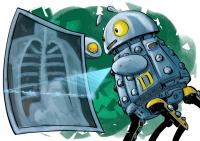Artificial intelligence will help diagnose lung disease
Scientists from the WUT Faculty of Mathematics and Information Science are working on improving identification of pathological changes visible in lung CT scans and x-rays. The project will aid doctors and patients.
Imaging is crucial in diagnosing lung disease (ranging from cancer to changes typical for pneumonia, also those caused by COVID-19). The interpretation of results is a challenge, however, even for experienced radiologists and available algorithms. To facilitate this process, Warsaw University of Technology scientists have decided to use the possibilities offered by the artificial intelligence.
‘We are planning to build an IT system which will aid radiologists through enriching CT and x-ray images with additional information/metafeatures,’ says professor Przemysław Biecek, project leader and head of the team MI2DataLab.
Analysis like never before
The tool will enable multi-faceted analysis of images and will be developed so as to enable an extension of the basic model with modules that detect a wide range of features.
‘This solution is not only more efficient but also easier to use and develop than many modules which verify a narrow range of changes,’ explains professor Biecek.
The idea is also exceptional thanks to an extended module with reliable artificial intelligence.
This means that the tool will allow the user to follow the decision-making process behind specific prognosis, and thus provide a greater transparency and safety of recommendations.
‘Models which behave like a black box are not reliable, they are prone to errors which are difficult to detect,’ adds professor Biecek. ‘For a few years, our team has been developing solutions which increase the transparency of the models. The new project is based on our original solutions.’
The scientists are planning to use various available databases, e.g., lung cancer cases, examinations of children and of COVID-19 patients. They also want to develop three unique databases of unprecedented representativeness, specifically for the purposes of the project and in cooperation with doctors.
What will the ready product be like?
‘Our solution will comprise an artificial intelligence module and a user interface which will allow the radiologist to communicate with the AI module,’ says professor Biecek. ‘The tool will be integrated with systems already used by doctors in their offices.’
The project will be completed by an interdisciplinary team: specialists in software engineering, artificial intelligence, explainable machine learning, data imaging and radiology.
Everything is planned for the system to work quickly, safely and effectively. It is crucial when it comes to medical diagnostics.
‘Now we are expanding the base of hospitals and radiologists cooperating with us; we will make the first prototype available for them in a year, or a year and a half, and a fully functional version is planned to be launched in three years’ time,’ says professor Biecek.
The project ”Reliable artificial intelligence facilitating identification of pathological changes in lungs on the basis of imaging examinations” (XLUNGS) is funded by the National Centre for Research and Development within the competition INFOSTRATEG I
Project leader: professor Przemysław Biecek
Task leaders: Elżbieta Sienkiewicz, PhD (explainable predictive modelling), Marcin Luckner, PhD (IT solutions), Przemysław Bombiński, PhD (radiological solutions)
Project completion period: 1 October 2021 – 31 May 2025








